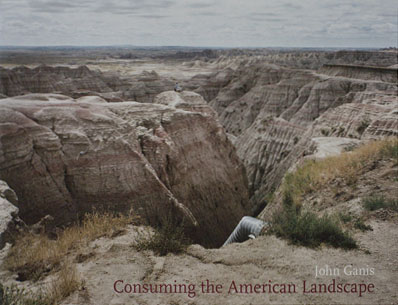
| |


Slide Show:
|
Connecting the Dots by George F. Thompson It is hard not to feel a bit guilty when viewing John Ganis's remarkable photographs of the American landscape, but guilt it not supposed to be part of the American dream. Self-reliance, perhaps, certainly freedom, but not guilt. Guilt is more often a peculiar side-effect of certain brands of Western religion. In many parts of America, consumption has become a kind of religion, practiced with great fervor. Expert economists and esteemed politicians tell us that "spending will get us out of the recession," the advertisers proclaim that "to save money you must buy more," and what was a luxury for the last generation is a necessity to most of us now. This pattern of consumption will go on endlessly, it seems, until there is a judgment day, either environmental or economic. And the oceans' waters are a rising tide. Most Americans pay little attention to their buying habits. They do not associate consumption with greed or guilt. Each one of us daily adds to the societal need to use and generate land in ways that John Ganis clearly points us toward. His landscapes are the results of our buying and disposal, spending and waste. Are they beautiful and scenic? Are they useful and of lasting value? Like a national park? Like a well-tended garden? Like a public park? Like a place you would want to pass on to the next generation? This interrogation is what photography can do for you. It can enlighten, inspire, inform, and disarm you with the visual truth. A truth exposed in John Ganis's photographs that leads directly back to our insatiable needs. Need another computer because the current one isn't quite as fast as the newest model? No problem, let's throw away the current one into a landfill and open up another mine; it only takes thirty or more different minerals to make a computer. Need a little more electricity to power up that hot tub or warm up and cool down that new home in the 'burbs? No problem, let's strip away a little more of that coal and reclaim it, "if we can afford to," bemoan the chambers of commerce. Need to add on to that 5,000-square-foot home that, all of a sudden, isn't quite big enough for the two of you? No problem, let's go cut those nice big trees in the national forests. See how guilt can enter the picture like a flash of light? After all, landscapes and places, as physical realities, do not lie. They lay before us as evidence of our deeds, our aspirations, our shortcomings. The landscapes and places in John Ganis's photographs tell us the oft-forgotten story that, until we connect the dots between our addiction to consumption and the need to heal the landscapes of consumption, there is much to feel guilty about. Even those who adhere to the idea of an unspoiled creation know how difficult it is to be responsible for one's actions on Earth. John Ganis did not seek out these landscapes of America, but they found him through his lens. They showed him that there is a direct relationship between one's lifestyle and one's national landscape, that every time you need something you can buy it, with cash or, better yet, on credit with low financing. The beauty of it all is that so few of us have to see, much less explain or rectify, the landscapes and places that John Ganis has found for us all to view, from sea to shining sea. John Ganis's images should make us feel a bit guilty, a bit on edge, for we have not taken the time to realize how our very being affects the land itself. What John Ganis finds so discomforting is our apparent unwillingness to connect the dots, so that we might soon become better caretakers of the American landscape. If we are going to drive our SUVs around and push urbanized society farther out into the countryside, then we should be willing to pay the price for mitigating the impact of our habits, to heal the land for the generations to come even as we strive to make an honest living. America is as much about its diverse lands as it is about its multiple ideas; the two are inseparable, and they provide us with hope that we can do better. And when we see images such as those by John Ganis, they penetrate the head, heart, and soul with their unique blend of sorrow and aesthetic appeal. They direct us to overcome the guilt of seeing land mistreated in the interests of self-indulgence by changing our patterns of consumption and connecting the dots between extraction and restoration of our land. They implore us to create better places in which to live, work, and explore. They instill in us the hope for a better life, and therein lies a dream that all Americans can embrace and be proud of. ©2013. All rights reserved.
|